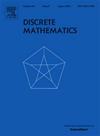A safeness condition for minimal separators based on vertex connectivity
IF 0.7
3区 数学
Q2 MATHEMATICS
引用次数: 0
Abstract
The treewidth is a measure that quantifies how tree-like a graph is. Its interest stems from the fact that many problems on graphs that are NP-complete for arbitrary graphs become solvable in polynomial time when restricted to graphs with bounded treewidth. Unfortunately, computing the treewidth of a graph is itself an NP-complete problem. A preprocessing technique that has proven to be highly effective at reducing the size of a graph for which the treewidth is to be computed is splitting the graph into multiple smaller subgraphs using separators that are safe for treewidth, allowing the treewidth of the complete graph to be computed as the maximum treewidth over these subgraphs. This paper introduces a new class of safe separators that largely generalises the existing classes of safe separators and opens up the possibility of designing even more powerful preprocessing techniques. An experimental evaluation on a set of synthetic graphs with known safe separators demonstrates that decomposing the graphs using their safe separators has the potential to reduce the execution time of algorithms by up to 10 times in many cases, with a maximum of more than 100 times in the most favourable cases. A heuristic decomposition algorithm is also presented that uses the community structure of a graph to decompose it into subgraphs. The evaluation of this heuristic algorithm on both the synthetic graphs and the graphs from the PACE challenge of 2017 using the same algorithms shows that the potential reduction in execution time is largely maintained while having only a slight impact on the quality as a result of the heuristic-based decomposition.
基于顶点连通性的最小分隔符的安全条件
树宽是一种量化图的树状程度的度量。它的兴趣源于这样一个事实,即许多图上的任意图的np完全问题,当被限制为具有有界树宽的图时,可以在多项式时间内解决。不幸的是,计算图的树宽本身就是一个np完全问题。一种预处理技术已经被证明在减少要计算树宽的图的大小方面非常有效,它使用对树宽安全的分隔符将图分割成多个更小的子图,允许计算完整图的树宽作为这些子图的最大树宽。本文介绍了一类新的安全分离器,它在很大程度上概括了现有的安全分离器,并为设计更强大的预处理技术开辟了可能性。对一组具有已知安全分隔符的合成图的实验评估表明,在许多情况下,使用它们的安全分隔符分解图有可能将算法的执行时间减少10倍,在最有利的情况下,最多可减少100倍以上。提出了一种利用图的群体结构将图分解为子图的启发式分解算法。对该启发式算法在合成图和2017年PACE挑战赛中使用相同算法的图上的评估表明,由于基于启发式的分解,执行时间的潜在减少在很大程度上保持不变,而对质量的影响很小。
本文章由计算机程序翻译,如有差异,请以英文原文为准。
求助全文
约1分钟内获得全文
求助全文
来源期刊

Discrete Mathematics
数学-数学
CiteScore
1.50
自引率
12.50%
发文量
424
审稿时长
6 months
期刊介绍:
Discrete Mathematics provides a common forum for significant research in many areas of discrete mathematics and combinatorics. Among the fields covered by Discrete Mathematics are graph and hypergraph theory, enumeration, coding theory, block designs, the combinatorics of partially ordered sets, extremal set theory, matroid theory, algebraic combinatorics, discrete geometry, matrices, and discrete probability theory.
Items in the journal include research articles (Contributions or Notes, depending on length) and survey/expository articles (Perspectives). Efforts are made to process the submission of Notes (short articles) quickly. The Perspectives section features expository articles accessible to a broad audience that cast new light or present unifying points of view on well-known or insufficiently-known topics.
 求助内容:
求助内容: 应助结果提醒方式:
应助结果提醒方式:


